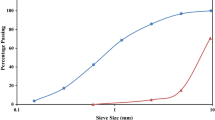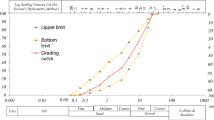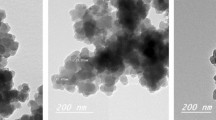Abstract
In this paper, an experimental study of the mechanical and rheological properties of self-compacting concrete (SCC) containing Al2O3 nanoparticles (AL2O3 NPs) and silica fume (SF) has been investigated. In order to evaluate the fresh properties of concrete, Slump flow, V-funnel, and L-box tests have been conducted. The hardened concrete properties have been investigated using compressive and tensile strength tests. Also, water absorption of specimens has been evaluated using the water absorption test. Thirteen different amounts of AL2O3 NPs (0, 0.25, 0.5, 0.75, 1, 1.25, 1.5, 1.75, 2, 2.25, 2.5, 2.75, and 3%) as a substitute of cement were used. The amount of SF in all specimens is considered constant. According to the tests, the compressive strength of specimens containing 2.5% AL2O3 NPs as partial cement replacement after 7, 28, and 90 days is increased by 47, 88, and 86%, respectively. The reason for this enhancement is the reactivity of the AL2O3 NPs with Portland cement during the hydration process of cement. Also, the splitting tensile strength of specimens containing 2.5% AL2O3 NPs and 10% SF as partial cement replacement after 7, 28, and 90 days is increased by 29, 55, and 47%, respectively. On the other hand, the use of 1 and 2% of aluminum nanoparticles also reduced water absorption by 10% and 45%, respectively. In other words, the use of SCC in SCC containing silica fume has a positive effect and can be effective in cases where low water absorption is required.













Similar content being viewed by others
References
Agarkar SV, Joshi MM (2012) Study of effect of Al2O3 nanoparticles on the compressive strength and workability of blended concrete. Int J Curr Res 4:382–384
Al Ghabban A, Al Zubaidi AB, Jafar M, Fakhri Z (2018) Effect of nano SiO2 and nano CaCO3 on the mechanical properties, durability and flowability of concrete. In: IOP conference series: materials science and engineering, vol 454, no 1, IOP Publishing, p 012016
Arefi M, Javeri M, Mollaahmadi E (2011) To study the effect of adding Al2O3 nanoparticles on the mechanical properties and microstructure of cement mortar. Life Sci J 8(4):613–617
Aslani F (2015) Nanoparticles in self-compacting concrete—a review. Mag Concr Res 67(20):1084–1100
ASTM Standard C642-13 (2013) Standard test method for density, absorption, and voids in hardened concrete. ASTM International, West Conshohocken, PA
ASTM Standard C496/C496M-17 (2017) Standard test method for splitting tensile strength of cylindrical concrete specimens, ASTM International, West Conshohocken, PA
ASTM Standard C192/C192M-18 (2018) Standard practice for making and curing concrete test specimens in the laboratory, ASTM International, West Conshohocken, PA
ASTM Standard C33/C33M-18 (2018) Standard specification for concrete aggregates. ASTM International, West Conshohocken, PA
ASTM Standard C39/C39M-18 (2018) Standard test method for compressive strength of cylindrical concrete specimens, ASTM International, West Conshohocken, PA
Beigi MH, Berenjian J, Omran OL, Nik AS, Nikbin IM (2013) An experimental survey on combined effects of fibers and nano-silica on the mechanical, rheological, and durability properties of self-compacting concrete. Mater Des 50:1019–1029. https://doi.org/10.1016/j.matdes.2013.03.046
CEB-FIP Model code (1990) Comite euro-international du beton. Thomas Telford, London
Diab AM, Elyamany HE, Elmoaty AEMA, Sreh MM (2019) Effect of nanomaterials additives on performance of concrete resistance against magnesium sulfate and acids. Constr Build Mater 210:210–231. https://doi.org/10.1016/j.conbuildmat.2019.03.099
Calvo JG, Pérez G, Carballosa P, Erkizia, E, Gaitero JJ, Guerrero A (2019) The effect of nanoparticles on the self-healing capacity of high-performance concrete. In: Nanotechnology in eco-efficient construction, Woodhead Publishing, pp 43–67. https://doi.org/10.1016/b978-0-08-102641-0.00003-7
Fidjestol P, Lewis R (1998) Microsilica as an addition. In: Lea’s chemistry of cement and concrete, Butterworth-Heinemann, pp 679–712
Ghasemi M, Ghasemi MR, Mousavi SR (2019) Studying the fracture parameters and size effect of steel fiber-reinforced self-compacting concrete. Constr Build Mater. https://doi.org/10.1016/j.conbuildmat.2018.12.172
Ghrici M, Kenai S, Said-Mansour M, Kadri EH (2006) Some engineering properties of concrete containing natural pozzolana and silica fume. J Asian Archit Build Eng 5(2):349–354. https://doi.org/10.3130/jaabe.5.349
Grzeszczyk S, Jurowski K, Bosowska K, Grzymek M (2019) The role of nanoparticles in decreased washout of underwater concrete. Constr Build Mater 203:670–678. https://doi.org/10.1016/j.conbuildmat.2019.01.118
Hanumesh BM, Varun BK, Harish BA (2015) The mechanical properties of concrete incorporating silica fume as partial replacement of cement. Int J Emerg Technol Adv Eng 5(9):270
Hase BA, Rathi VR (2015) Properties of high strength concrete incorporating colloidal nano-Al2O3. Int J Innov Res Sci Eng Technol 4(3):959–963. https://doi.org/10.15680/IJIRSET.2015.0403024
Ismael R, Silva JV, Carmo RNF, Soldado E, Lourenco C, Costa H, Júlio E (2016) Influence of nano-SiO2 and nano-Al2O3 additions on steel-to-concrete bonding. Constr Build Mater 125:1080–1092. https://doi.org/10.1016/j.conbuildmat.2016.08.152
Jaishankar P, Karthikeyan C (2017) Characteristics of cement concrete with nano alumina particles. In: IOP conference series; earth and environmental science, vol 80, no 1, p 012005. https://doi.org/10.1088/1755-1315/80/1/012005
Jayaseelan R, Pandalu G, Selvam S (2019) Investigation on the performance characteristics of concrete incorporating nanoparticles. Jordan J Civ Eng 13(2):351–360
Kamal MM, Safan MA, Bashandy AA, Khalil AM (2018) Experimental investigation on the behavior of normal strength and high strength self-curing self-compacting concrete. J Build Eng 16:79–93. https://doi.org/10.1016/j.jobe.2017.12.012
Kaplan G, Demircan RK, Cakmak C, Gultekin AB (2019) Microwave curing effect on internal sulfate damage in nano alumina reinforced white cement. In: IOP conference series: materials science and engineering, vol 471, no 3, IOP Publishing, p 032038
Kawashima S, Hou P, Corr DJ, Shah SP (2013) Modification of cement-based materials with nanoparticles. Cement Concr Compos 36:8–15. https://doi.org/10.1016/j.cemconcomp.2012.06.012
Khan PS, Reddy MR, Shaik O (2018) An experimental study of the mechanical properties of glass fiber reinforced high strength concrete partially replacing cement with nano silica. Int J Eng Technol (IRJET) 5(04):4597–4602
Langaroudi MAM, Mohammadi Y (2018) Effect of nano-clay on workability, mechanical, and durability properties of self-consolidating concrete containing mineral admixtures. Constr Build Mater 191:619–634. https://doi.org/10.1016/j.conbuildmat.2018.10.044
Li Z, Wang H, He S, Lu Y, Wang M (2006) Investigations on the preparation and mechanical properties of the nano-alumina reinforced cement composite. Mater Lett 60(3):356–359. https://doi.org/10.1016/j.matlet.2005.08.061
Li Z, Han B, Yu X, Dong S, Zhang L, Dong X, Ou J (2017) Effect of nano-titanium dioxide on mechanical and electrical properties and microstructure of reactive powder concrete. Mater Res Express 4(9):095008
Luo X, Si Y, Gu W (2019) Effect of silica fume on mechanical properties of concrete incorporating steel slag powder. Wuhan Univ J Nat Sci 24(1):86–92. https://doi.org/10.1007/s11859-019-1372-z
Mehta PK, Monteiro P (1999) Concrete microstructure, properties, and materials, 3rd edn. Indian Concrete Institute, Delhi
Mohseni E, Khotbehsara MM, Naseri F, Monazami M, Sarker P (2016) Polypropylene fiber reinforced cement mortars containing rice husk ash and nano-alumina. Constr Build Mater 111:429–439. https://doi.org/10.1016/j.conbuildmat.2016.02.124
Mukhopadhyay A (2011) Next-generation nano-based concrete construction products: a review. Nanotechnol Civ Infrastruct. https://doi.org/10.1007/978-3-642-16657-0_7
Nazari A, Riahi S (2011) Effects of Al2O3 nanoparticles on properties of self-compacting concrete with ground granulated blast furnace slag (GGBFS) as binder. Technol Sci 54:2327–2338
Nazari A, Riahi S, Riahi S, Shamekhi SF, Khademno A (2010a) Mechanical properties of cement mortar with Al2O3 nanoparticles. J Am Sci 6:94–97
Nazari A, Riahi S, Riahi S, Shamekhi SF, Khademno A (2010b) Influence of Al2O3 nanoparticles on the compressive strength and workability of blended concrete. J Am Sci 6(5):6–9
Neville AM, Brooks JJ (1987) Concrete technology. Longman Scientific & Technical, London
Niewiadomski P, Stefaniuk D, Hoła J (2017) Microstructural analysis of self-compacting concrete modified with the addition of nanoparticles. Procedia Eng 172:776–783. https://doi.org/10.1016/j.proeng.2017.02.122
Nikbin IM, Beygi MHA, Kazemi MT, Amiri JV, Rahmani E, Rabbanifar S, Eslami M (2014) A comprehensive investigation into the effect of aging and coarse aggregate size and volume on mechanical properties of self-compacting concrete. Mater Des 59:199–210. https://doi.org/10.1016/j.matdes.2014.02.054
Nili M, Ehsani A (2015) Investigating the effect of the cement paste and transition zone on strength development of concrete containing nanosilica and silica fume. Mater Des 75:174–183. https://doi.org/10.1016/j.matdes.2015.03.024
Oltulu M, Sahin R (2011) Single and combined effects of nano-SiO2, nano-Al2O3 and nano-Fe2O3 powders on compressive strength and capillary permeability of cement mortar containing silica fume. Mater Sci Eng 528:7012–7019. https://doi.org/10.1016/j.msea.2011.05.054
Oltulu M, Sahin R (2013) Effect of nano-SiO2, nano-Al2O3 and nano-Fe2O3 powders on compressive strengths and capillary water absorption of cement mortar containing fly ash: a comparative study. Energy Build 58:292–301
Papatzani S, Paine K, Calabria-Holley J (2014) The effect of the addition of nanoparticles of silica on the strength and microstructure of blended Portland cement pastes. In: 2014 international concrete sustainability conference, Boston
Paul SC, Van Rooyen AS, Van Zijl GP, Petrik LF (2018) Properties of cement-based composites using nanoparticles: a comprehensive review. Constr Build Mater 189:1019–1034. https://doi.org/10.1016/j.conbuildmat.2018.09.062
Quercia G, Spiesz P, Hüsken G, Brouwers HJH (2014) SCC modification by use of amorphous nano-silica. Cement Concr Compos 45:69–81. https://doi.org/10.1016/j.cemconcomp.2013.09.001
Salemi N, Behfarnia K (2013) Effect of nano-particles on durability of fiber-reinforced concrete pavement. Constr Build Mater 48:934–941. https://doi.org/10.1016/j.conbuildmat.2013.07.037
Self-Compacting Concrete European Project Group (2005) The European guidelines for self-compacting concrete: specification, production and use. In: International Bureau for Precast Concrete (BIBM)
Staub de Melo JV, Triches G (2018) Study of the influence of nano-TiO2 on the properties of Portland cement concrete for application on road surfaces. Road Mater Pavement Des 19(5):1011–1026. https://doi.org/10.1080/14680629.2017.1285811
Tichko S, De Schutter G, Troch P, Vierendeels J, Verhoeven R, Lesage K, Cauberg N (2015) Influence of the viscosity of self-compacting concrete and the presence of rebars on the formwork pressure while filling bottom-up. Eng Struct 101:698–714
Vandhiyan R, Pillai EB (2018) influence of nano silica addition on the behavior of concrete and its impact on corrosion resistance. J Comput Theor Nanosci 15(2):530–536. https://doi.org/10.1166/jctn.2018.7116
Vera-Agullo J, Chozas-Ligero V, Portillo-Rico D, García-Casas MJ, Gutiérrez-Martínez A, Mieres-Royo JM, Grávalos-Moreno J (2009) Mortar and concrete reinforced with nanomaterials. In: Nanotechnology in construction, vol 3, Springer, Berlin, pp 383–388
Zhang S, Qiao WG, Chen PC, Xi K (2019) Rheological and mechanical properties of microfine-cement-based grouts mixed with microfine fly ash, colloidal nanosilica and superplasticizer. Constr Build Mater 212:10–18
Author information
Authors and Affiliations
Corresponding author
Rights and permissions
About this article
Cite this article
Faez, A., Sayari, A. & Manie, S. Mechanical and Rheological Properties of Self-Compacting Concrete Containing Al2O3 Nanoparticles and Silica Fume. Iran J Sci Technol Trans Civ Eng 44 (Suppl 1), 217–227 (2020). https://doi.org/10.1007/s40996-019-00339-y
Received:
Accepted:
Published:
Issue Date:
DOI: https://doi.org/10.1007/s40996-019-00339-y




